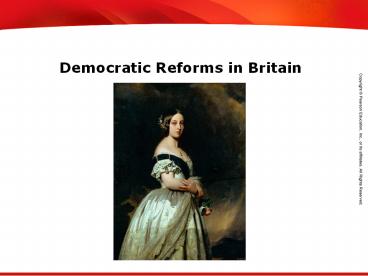Democratic Reforms in Britain - PowerPoint PPT Presentation
1 / 16
Title:
Democratic Reforms in Britain
Description:
Democratic Reforms in Britain Describe how reformers worked to change Parliament in the 1800s. Understand the values that Queen Victoria represented. – PowerPoint PPT presentation
Number of Views:280
Avg rating:3.0/5.0
Title: Democratic Reforms in Britain
1
Democratic Reforms in Britain
2
Objectives
- Describe how reformers worked to change
Parliament in the 1800s. - Understand the values that Queen Victoria
represented. - Summarize how the Liberal and Conservative
parties helped bring a new era to British
politics.
3
Terms and People
- rotten borough rural town in England that sent
members to Parliament despite having few or no
voters - electorate the body of people allowed to vote
- secret ballot votes cast without announcing
them publicly - Queen Victoria longest-reigning monarch in
British history embodied the values of her age
including duty, thrift, honesty, hard work, and
respectability
4
Terms and People (continued)
- Benjamin Disraeli leader of the Conservative
Party pushed the Reform Bill of 1867 to increase
suffrage in England - William Gladstone leader of the Liberal Party
worked to extend suffrage to farm workers and
most other men - parliamentary democracy a form of government
where ministers are chosen by, responsible to,
and members of an elected legislature or
parliament
5
How did political reform gradually expand
suffrage and make the British Parliament more
democratic during the 1800s?
Benjamin Disraeli described Britain in the 1800s
as two nations, one rich, one poor. He and
other political leaders slowly worked to bridge
the gap by extending democratic rights.
Unlike some of its neighbors in Europe, Britain
generally achieved change through reform rather
than revolution.
6
In 1815, Britain was a constitutional monarchy.
- The House of Lords was made up of hereditary
nobles and high-ranking clergy. - Members of the House of Commons were popularly
elected, but only 5 percent of the people could
vote. - The House of Lords had the power to veto bills
passed by the House of Commons.
Despite a Parliament and two political parties,
Britain was far from democratic.
7
Long-standing laws kept the system from becoming
more democratic.
- Catholics and non-Anglican Protestants were
denied the vote. - Workers were moving from rural areas to new
cities. Yet large landowners in these depopulated
rural areas, or rotten boroughs, maintained seats
in Parliament while growing cities had none.
8
The two political parties battled over attempts
to reform the political system.
The Whig Party represented businessmen and the
middle class looking for reform.
9
- The bill enlarged the electorate, allowing more
men to vote. - In 1832, Parliament changed the distribution of
seats to eliminate rotten boroughs.
The Great Reform Act of 1832 finally brought
change.
The electorate grew, but one still had to own
property to vote. The middle class gained power,
but the House of Lords still controlled
Parliament.
10
The Reform Act did nothing to help urban or rural
workers. Radical protesters demanded greater
change.
- Known as Chartists, they drew up a list of
demands called the Peoples Charter. - Demands included universal male suffrage and
voting by secret ballot. - Twice, Parliament ignored million-signature
Chartist petitions. In 1848, Chartist marches
were banned. - Eventually, Parliament passed most of the reforms
proposed by the Chartists.
11
The period from 1837 to 1901 is known asthe
Victorian age.
- Although she had little real power, Queen
Victoria set the tone for her age. - During her 64-year reign, she came to symbolize
British beliefs and values.
12
The queen embodied a strict code of morals and
manners.
- Victorian values included thrift, honesty, duty,
hard work, and respectability. - The middle class gained new confidence under her
reign as Britains empire grew. - Her sympathy for the poor working class
encouraged reformers seeking social change.
13
- Benjamin Disraeli reformed the Tories into the
modern Conservative Party. - William Gladstone led the new Liberal Party that
evolved from the Whigs.
The 1860s were the dawn of a new age in British
politics as the old parties regrouped under new
leaders.
14
Between 1868 and 1880, Gladstone and Disraeli
alternated as prime minister.
Both men pushed reforms that increased the size
of the electorate.
15
- After Commons threatened to appoint a flood of
new lords, the House of Lords backed down. - In 1911, most of the Lords power was removed.
Today the House of Lords is largely ceremonial.
16
Britain had transformed itself from a
constitutional monarchy to a parliamentary
democracy.
- Government ministers were elected by, responsible
to, and members of Parliament. - The Chartist goals of universal male suffrage
and a secret ballot were almost completely met. - In 1918, women over 30 were also given the vote.































